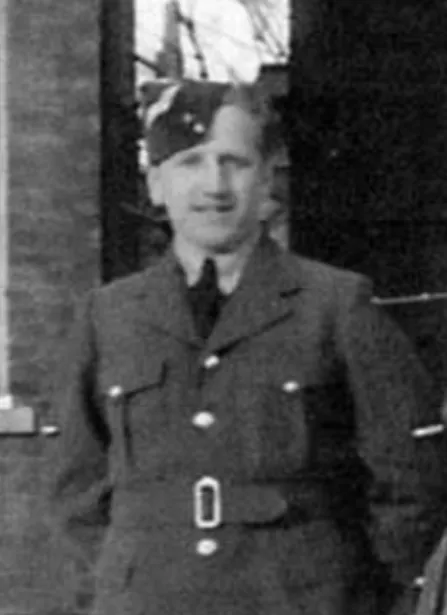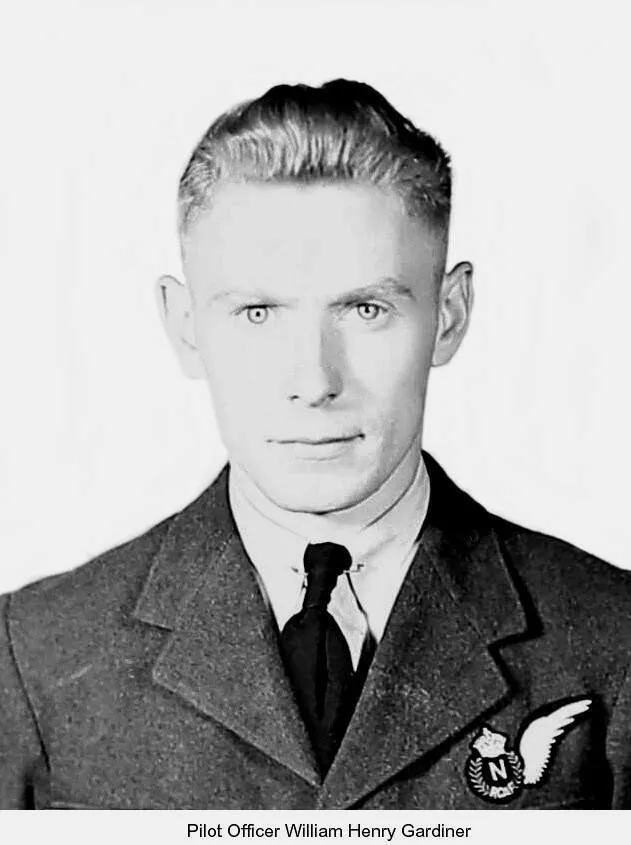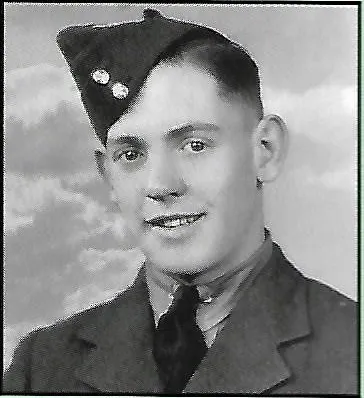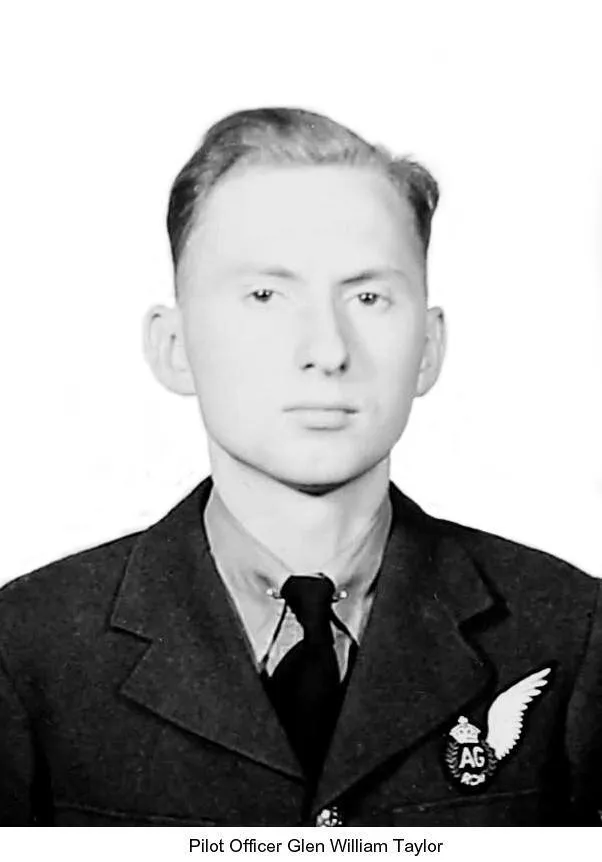Wilson, Sidney Albert (Pilot Officer)
Killed in Action 1944-June-17


Birth Date: 1915-March-26
Born: Toronto, Toronto Municipality, Ontario, Canada
Parents: Son of Arthur Samuel Wilson and Jennie Vilmetta (nee Short) Wilson
Spouse: Husband of Marjorie Wilson, of Guelph, Ontario.
Home: Whitby, Ontario
Enlistment: Hamilton, Ontario
Enlistment Date: 1942-September-28
Service
RCAF
Unit
419 (B) Sqn- Squadron
Moosa Aswayita Beware of Moose
Base
RAF Middleton St George
Rank
Pilot Officer
Position
Air Gunner (Rear)
Service Numbers
J/92343
Prev: R/193100
Crew or Other Personnel
Lancaster KB734
Mission
Lancaster Mk.X KB734
Bombing Sterkrade Germany 1944-June-16 to 1944-June-17
419 (B) Sqn (RCAF) RAF Middleton St. George
Battle of Normandy
321 aircraft- 162 Halifaxes, 147 Lancasters, 12 Mosquitoes - of 1, 4, 6 and 8 Groups to attack the synthetic-oil plant despite a poor weather forecast.
The target was found to be covered by thick cloud and the Pathfinder markers quickly disappeared. The Main Force crews could do little but bomb on to the diminishing glow of the markers in the cloud. R.A.F. photographic reconnaissance and German reports agree that most of the bombing was scattered, although some bombs did fall in the plant area, but with little effect upon production. 21 Germans and 6 foreigners were killed and 18 houses in the vicinity were destroyed
Unfortunately, the route of the bomber stream passed near a German night-fighter beacon at Bocholt, only 30 miles from Sterkrade. The German controller had chosen this beacon as the holding point for his night fighters. Approximately 21 bombers were shot down by fighters and a further 10 by Flak. 22 of the lost aircraft were Halifaxes, these losses being 13.6 per cent of the 162 Halifaxes on the raid. 77 Squadron, from Full Sutton near York, lost 7 of its 23 Halifaxes taking part in the raid419 Moose Squadron (Moosa Aswayita) RAF Middleton St George. Lancaster BX aircraft KB 734 VR-F missing during a night operation to bomb the synthetic oil plants at Sterkrade, Germany
The Lancaster was shot down by night fighter pilot Unteroffizier Gustav Sarzio of 6/NJG 1, from Deelen airfield in Messerschmitt Bf 110 G-4 G9+JP. The bomber crashed at Utrechtseweg 48, Zeist (Utrecht), Netherlands
Flight Lieutenant Ernest Sutton Smith KC (RCAF), Pilot Officer Michael Baran (RCAF), Pilot Officer Glen William Taylor (RCAF), Pilot Officer William Henry Gardiner (RCAF), and Pilot Officer Sidney Albert Wilson (RCAF)(attached from 434 Sqn) were all killed in action
Sergeant Robert Edward Porter (RCAF) survived and evaded capture until January 1945, when he was captured and taken as Prisoner of War
Sergeant John William Albert Trussler (RAFVR) survived and was taken Prisoner of War
There were two 419 Squadron Lancaster BX aircraft lost on this operation. Please see aircraft serial KB 728 VR-V for information on this aircraft and crew
The Bomber Command War Diaries, Martin Middlebrook and Chris Everitt
Nachtjagd Combat Archive 1944 Part 3 12 May - 23 July, page 67
![]() Royal Air Force Serial and Image Database
Royal Air Force Serial and Image Database
![]() 419 Squadron RCAF 1941 to 1945 Crew of Lancaster KB734
419 Squadron RCAF 1941 to 1945 Crew of Lancaster KB734
![]() 16/17061944 419 (Moose) Squadron RCAF Lancaster X KB734 Flt Lt Ernes...
16/17061944 419 (Moose) Squadron RCAF Lancaster X KB734 Flt Lt Ernes...
![]() Lancaster crash in Zeist commemorated after 80 years with...
Lancaster crash in Zeist commemorated after 80 years with...
Lancaster serial: KB734

Canadian Warplane Heritage Museum
The Avro Lancaster is a British Second World War heavy bomber. It was designed and manufactured by Avro as a contemporary of the Handley Page Halifax, both bombers having been developed to the same specification, as well as the Short Stirling, all three aircraft being four-engined heavy bombers adopted by the Royal Air Force (RAF) during the same wartime era.
The Lancaster has its origins in the twin-engine Avro Manchester which had been developed during the late 1930s in response to the Air Ministry Specification P.13/36 for a capable medium bomber for "world-wide use". Originally developed as an evolution of the Manchester (which had proved troublesome in service and was retired in 1942), the Lancaster was designed by Roy Chadwick and powered by four Rolls-Royce Merlins and in one version, Bristol Hercules engines. It first saw service with RAF Bomber Command in 1942 and as the strategic bombing offensive over Europe gathered momentum, it was the main aircraft for the night-time bombing campaigns that followed. As increasing numbers of the type were produced, it became the principal heavy bomber used by the RAF, the Royal Canadian Air Force (RCAF) and squadrons from other Commonwealth and European countries serving within the RAF, overshadowing the Halifax and Stirling. Wikipedia
Unit Desciption
419 (B) Sqn Moosa Aswayita ("Moose")
History of the Squadron during World War II (Aircraft: Wellington IC, III, Halifax II, Lancaster X)
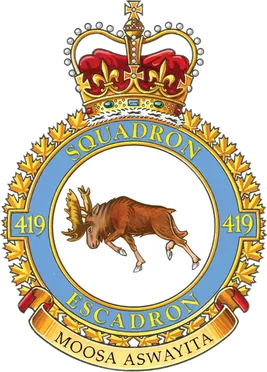
419 (Bomber) Squadron formed at RAF Mildenhall, Suffolk, UK ![]() in 1941 as part of No 3 Group of Bomber Command. It got its name from its first commanding officer, Wing Commander John "Moose" Fulton, DSO, DFC, AFC. The squadron operated Vickers Wellington, then Handley Page Halifax and finally Avro Lancaster bombers through the course of WWII, with the squadron code letters VR. It was the third RCAF bomber unit to be formed in England. It started operations in January 1942, converting almost immediately from Wellington Mk ICs to Wellington Mk IIIs and then moving north to Leeming, Yorkshire,
in 1941 as part of No 3 Group of Bomber Command. It got its name from its first commanding officer, Wing Commander John "Moose" Fulton, DSO, DFC, AFC. The squadron operated Vickers Wellington, then Handley Page Halifax and finally Avro Lancaster bombers through the course of WWII, with the squadron code letters VR. It was the third RCAF bomber unit to be formed in England. It started operations in January 1942, converting almost immediately from Wellington Mk ICs to Wellington Mk IIIs and then moving north to Leeming, Yorkshire, ![]() as part of 4 Group Bomber Command in August 1942. After short stays at Topcliffe
as part of 4 Group Bomber Command in August 1942. After short stays at Topcliffe ![]() and Croft
and Croft ![]() , it moved to Middleton St. George, County Durham
, it moved to Middleton St. George, County Durham ![]() in November 1942, from which it flew until the end of hostilities. Here in November 1942 it was re-equipped with Halifax Mk IIs, which it flew for the next 18 months on the night offensive against Germany. In January 1943 it joined the newly formed 6 (RCAF) Group of Bomber Command.
in November 1942, from which it flew until the end of hostilities. Here in November 1942 it was re-equipped with Halifax Mk IIs, which it flew for the next 18 months on the night offensive against Germany. In January 1943 it joined the newly formed 6 (RCAF) Group of Bomber Command.
In April 1944 the squadron began to convert to the Avro Lancaster Mk X, which was produced in Canada and flown across the Atlantic. The squadron remained continuously on the offensive until 25 April 1945, when it flew its last sortie. Squadron personnel flew a total of 4,325 operational sorties during the war from Mannheim to Nuremberg, Milan to Berlin and Munich to Hanover, inflicting heavy damage on the enemy. On completion of the war in Germany, the squadron was earmarked to become part of the proposed "Tiger Force" to continue the war against Japan. However, the Japanese surrender in August 1945 led to the disbandment of the squadron in at Yarmouth, Nova Scotia ![]() September 1945.
September 1945.
As a result of its wartime record, 419 Squadron became one of the most decorated units under the RCAF during the war. Over a span of roughly three-and-a-quarter years it logged 400 operational missions (342 bombing missions, 53 mining excursions, 3 leaflet raids and 1 "spoof") involving 4,325 sorties. A total of one hundred and twenty nine aircraft were lost on these operations. Members of the squadron accumulated 1 VC, 4 DSO's, 1 MC, 150 DFC's, 3 bars to DFC, 1 CGM, 35 DFM's: the VC was awarded posthumously to Flight Sergeant Andrew Mynarski for his attempts to help a fellow crew member escape from their burning aircraft. Battle Honours were: English Channel and North Sea 1942-44, Baltic 1942-44, Fortress Europe 1942-44, France and Germany 1944-45, Biscay Ports 1942-44, Ruhr 1942-45, Berlin 1943-44, German Ports 1942-45, Normandy 1944, Rhine, Biscay 1942; 1944. Wikipedia, Kostenuk and Griffin
![]() Squadron History (Bomber Command Museum)
Squadron History (Bomber Command Museum)
Maps for Movements of 419 Squadron 1941-45
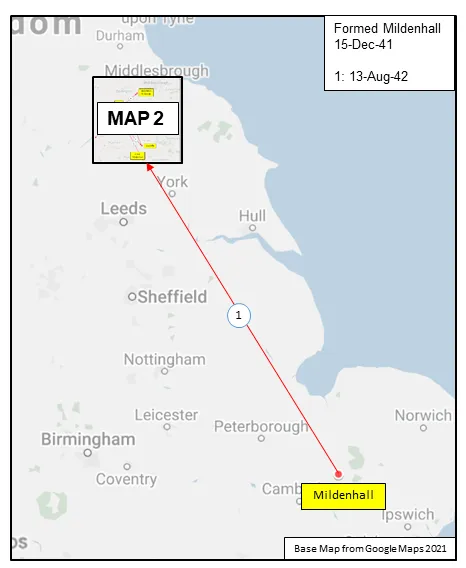
MAP 1: 419 Squadron Movements Dec 1941-Aug-42 (right-click on image to display enlarged new tab)
|
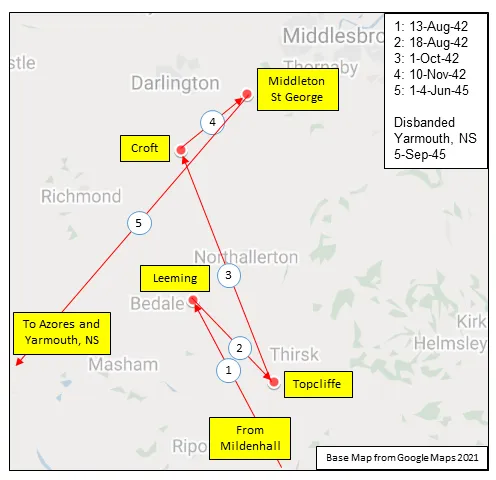
MAP 2: 419 Squadron Movements Aug 1942-Jun 1945
|
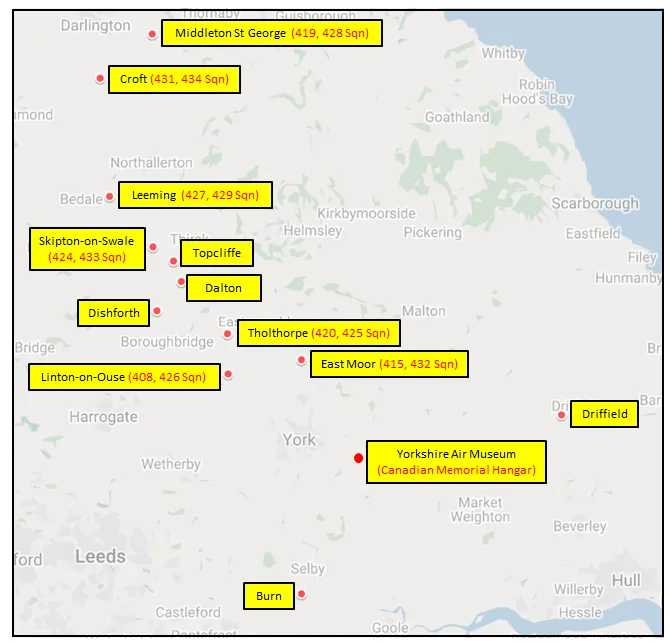
MAP 3: 6 Group Bomber Bases 1943-1945
|
419 Squadron History Summary 1941-45
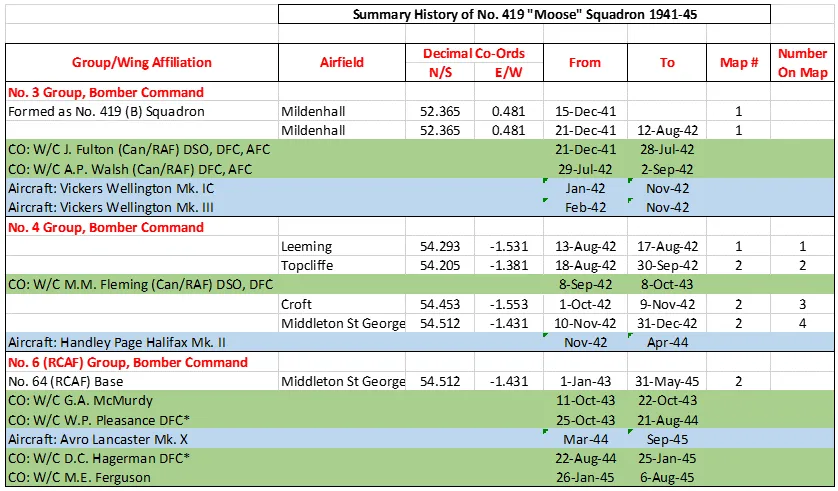
419 Squadron History Summary 1941-45 Page 2

History of the Squadron Post-WWII (Aircraft: Canuck, Silver Star, Freedom Fighter, Hornet)
The squadron was reactivated on 15 March 1954 at North Bay, Ontario ![]() , as an all-weather fighter squadron flying the CF-100 Canuck. It moved to the NATO Air Division base at Baden-Soellingen, Germany
, as an all-weather fighter squadron flying the CF-100 Canuck. It moved to the NATO Air Division base at Baden-Soellingen, Germany ![]() shortly after being formed. The squadron remained there until its disbandment in December 1962.
shortly after being formed. The squadron remained there until its disbandment in December 1962.
The squadron was again re-formed in December 1970, when it relocated to Cold Lake, Alberta ![]() as No. 1 Canadian Forces Flight Training School. It initially flew the T-33 Silver Star but then transitioned to the Canadair CF-5 Freedom Fighter. The squadron was on full active duty in November 1975 but disbanded again 20 years later when the CF-5’s were retired in June 1995.
as No. 1 Canadian Forces Flight Training School. It initially flew the T-33 Silver Star but then transitioned to the Canadair CF-5 Freedom Fighter. The squadron was on full active duty in November 1975 but disbanded again 20 years later when the CF-5’s were retired in June 1995.
The squadron was again reactivated as 419 Tactical Fighter (Training) Squadron on 23 July 2000. The squadron has since conducted Phase IV of the NATO Flying Training Canada (NFTC) program for the air forces of Canada, Austria, Denmark, Italy, Hungary, Saudi Arabia, Singapore, the United Arab Emirates and the United Kingdom. This program trains basic jet pilots to become fighter pilots and prepares them for training on CF-188 class aircraft through instruction in Air-to-Air and Air-to-Ground combat tactics over a six month period.
